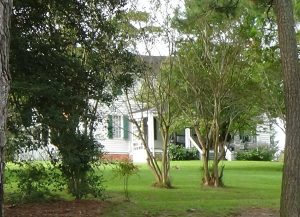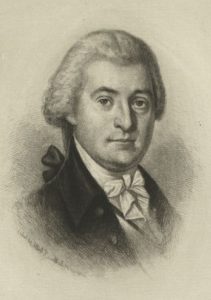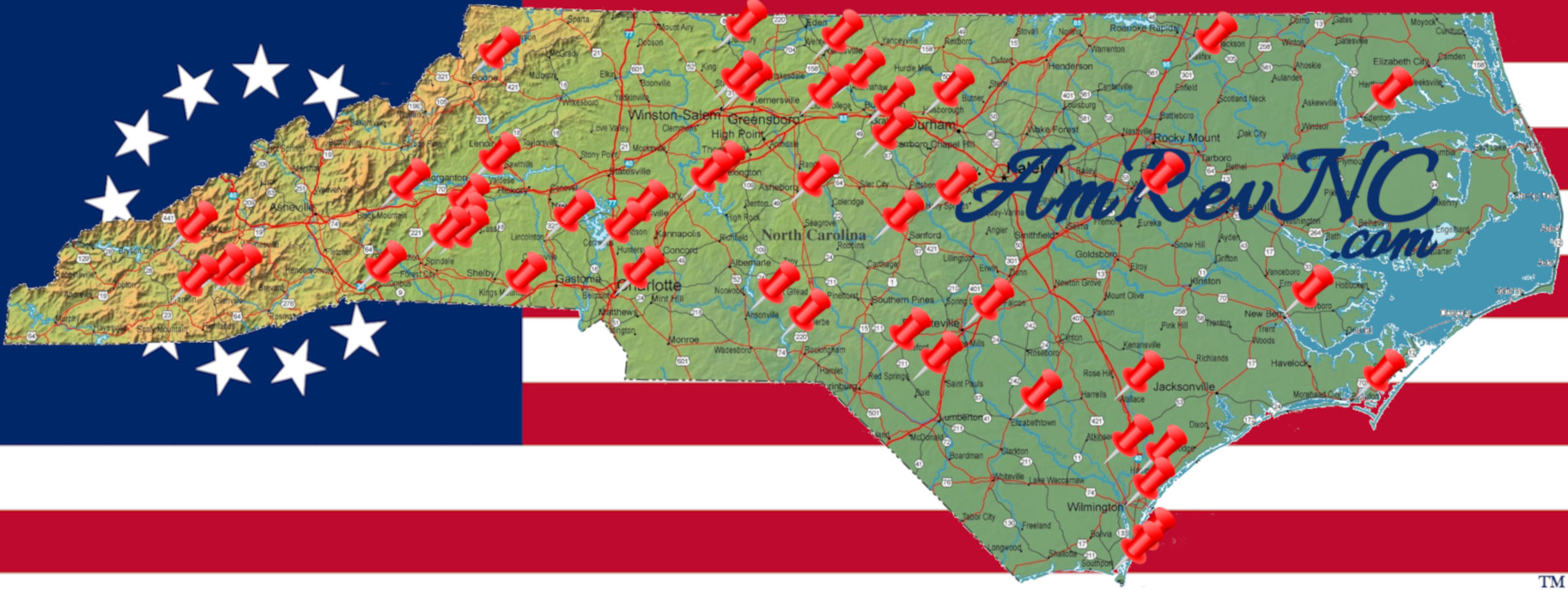A Constitutional Signer and Violator
Location
Other maps: Bing, Google, MapQuest.
Coordinates: 35.9951, -76.9473.
Type: Stop
Tour: Rebellion
County: Bertie
![]() Full
Full
Approach the coordinates from downtown Windsor, heading south on Sutton Drive. Park at the curb just before Gray Street, wherever you can see the white house at the top of the hill on the right.
For a closer look, smaller vehicles can turn right onto Gray, which narrows to driveway width with limited turnarounds. However in warmer months, when trees have their leaves, there is no good view of the house. Please respect the homeowners’ privacy.
Description
 The house you see at the top of the hill is the remaining physical sign of the Rosefield Plantation owned during the American Revolution by William Gray. Family tradition once held that the oldest part of the house was built by William’s father John Gray prior to the war. However, according to the form nominating it for the National Register of Historic Places, architectural and legal evidence show it was built by his grandson Stephen starting in 1786, on land still owned by William.[1]
The house you see at the top of the hill is the remaining physical sign of the Rosefield Plantation owned during the American Revolution by William Gray. Family tradition once held that the oldest part of the house was built by William’s father John Gray prior to the war. However, according to the form nominating it for the National Register of Historic Places, architectural and legal evidence show it was built by his grandson Stephen starting in 1786, on land still owned by William.[1]
In addition to running the 1,000-acre plantation’s farms, the form says, William Gray was a merchant and owned a shipyard. He was first elected to the Provincial Assembly in 1760, and later supported the Revolution. He served in the Third Provincial Congress in Hillsborough that set up Patriot defense forces and the fifth congress in Halifax that designed the new state government. The town of Windsor is built on a 100-acre lot of the plantation sold by William in 1768.[2]

It’s unclear where John Gray’s original home was on this plantation. But his daughter Barbara (William’s sister) and her husband Jacob Blount were living with John when their first child William made his appearance there in 1749. John died the following year, leaving the plantation to William Gray. Unrecorded is how many enslaved people came with it, though a few are listed in the will, such as Moll, Ned, and a “girl called Frank.”[a]
William Blount was six when his family moved to their new home, Blount Hall, south of today’s Greenville. Jacob eventually owned 6,000 acres and numerous business interests. William thus grew up in wealth, attending school in New Bern in addition to learning from his family’s private tutor. He then joined his father’s merchant business along with his brothers.
Like his father and most landowners in the eastern part of the colony, Blount opposed the Regulators in the late 1760s. Easterners were favored over westerners in tax policies and legislative representation, which the Regulators protested and then literally fought. Blount was in the royal governor’s army that defeated the Regulators at the Battle of Alamance near modern Burlington.[3]

When the American Revolution broke out, Blount was named paymaster for the 3rd North Carolina Regiment of the Continental Army, as well as for all N.C. militia (part-time soldiers). Though not a combat officer, Blount went with the regiment as it joined Gen. George Washington’s army and fought in several key battles, including at Germantown (Penn.). He and his brother John Gray Blount also commissioned four privateers, though no records indicate for sure that these legal pirates captured any British ships.[4]
After the N.C. regiments were reorganized due to casualties, Blount became chief paymaster for the state troops. He spent three years in a key role keeping state regiments supplied with men and equipment, though he was accused of personally buying and then reselling some materials to the state at inflated prices.[5] Blount also was elected to the early General Assembly and served for six years, including as Speaker of the House. When state forces had to be rebuilt again after the fall of Charleston in 1780, Blount joined up, only to be part of the crushing American defeat at the Battle of Camden (S.C.). Blount apparently escaped injury, but left the army after that experience.[6]
Windsor was a chaotic scene in late April 1781. Rumors arrived that a British force from Portsmouth, Va., (near Norfolk) was marching to burn Edenton to the east. The town offered to take in refugees, and many Edenton residents came here by boat. An historian wrote in 1857, “The village of Windsor… was crowded with fugitives, and its few houses literally swarmed with women and children; valuable furniture was thrust into barns, or slightly sheltered by open sheds; smokehouses were converted into kitchens, and ladies, educated in luxurious habits, were fain (willing) to prepare their slender meals with their own hands.”[b] If that last part was true, it raises the question of whether their enslaved cooks were left behind.
Post-war, Blount formed a highly successful merchant business with his brothers Thomas and John Gray Blount based in Washington, N.C. William was also a state delegate to the U.S. Constitutional Convention and signed that document. As president, George Washington named him Governor of the Territory of the United States South of the River Ohio (Kentucky and Tennessee), and Superintendent of Indian Affairs in the South. In the latter role, he was lead negotiator for the treaty by which the Cherokees gave up claim to much of their original homeland, already flooded with European-Americans. Their sense of the fairness of that treaty, as well as Blount’s reputation for land greed, may be seen in the Cherokees’ nickname for him: “Dirt Captain.”[7] His Tennessee Company unsuccessfully laid claim to 300,000 acres, a guessed-at number, and he directed company agents to file individual claims under “‘any Names fictious (sic) one will do.’”[8]
Blount was in Tennessee’s state constitutional convention and became one of its first two senators. However, his greatest “fame” came from violating the U.S. Constitution he helped create. Blount gave his name to a pre-existing conspiracy he took over, intended to help the British defeat the French and Spanish during their war over Florida and New Orleans in 1797. Because this interfered with the federal government’s authority over foreign relations, he was expelled from the U.S. Senate.[9] He is buried in Knoxville.
More Information
- Bullock, Marshall, ‘National Register of Historic Places—Nomination Form: Rosefield’ (United States Dept. of the Interior, National Park Service, 1982) <https://files.nc.gov/ncdcr/nr/BR0145.pdf> [accessed 2 March 2021]
- Edwards, Justin, ‘Tar River Blounts and a Transitional Maritime Cultural Landscape, 1778-1802’ (unpublished Master’s thesis, East Carolina University, 2015)
- Folmsbee, Stanley, ‘Blount, William’, NCpedia, 1979 <https://www.ncpedia.org/biography/blount-william> [accessed 21 September 2020]
- Green, C. Sylvester, Blounts of Pitt County (Pitt County, N.C.: Pitt County Historical Society, 1978)
- Isenberg, Nancy, White Trash: The 400-Year Untold History of Class in America (New York, NY: Viking, 2016).
- ‘John Gray (1691-1750)’, WikiTree FREE Family Tree <https://www.wikitree.com/wiki/Gray-1315> [accessed 30 October 2021]
- Keith, Alice Barnwell, ‘John Gray and Thomas Blount, Merchants, 1783-1800’, The North Carolina Historical Review, 25.2 (1948)
- McRee, Griffith John, Life and Correspondence of James Iredell: One of the Associate Justices of the Supreme Court of the United States (New York: Appleton, 1857), Vol. I
- Wegner, Ansley, ‘Blount Hall’, NCpedia, 2009 <https://www.ncpedia.org/blount-hall> [accessed 21 September 2020]
- ‘Why the Town of Blountville, Tennessee, Was Renamed West Point, Tennessee’, Files of the Blount-Bridger House, Tarboro, N.C.
- Wright, Jr., Robert, and Morris MacGregor, Jr., Soldier-Statesmen of the Constitution (U.S. Army Center of Military History, 1987) <https://history.army.mil/books/RevWar/ss/blount.htm> [accessed 18 September 2020]



